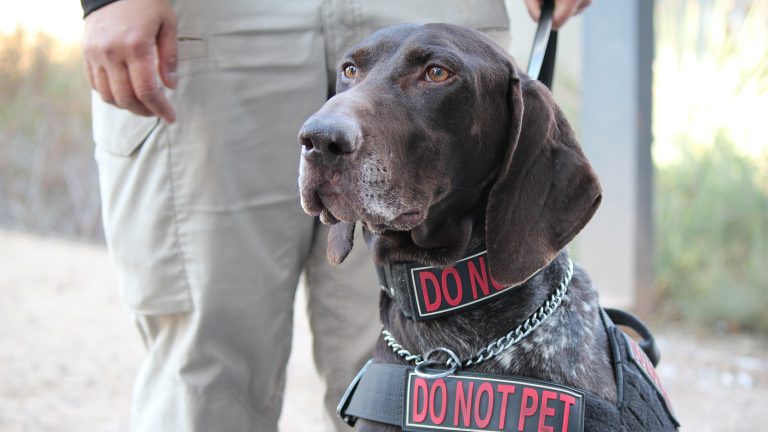
Tim Agne/KJZZ
Don, a German Shorthaired Pointer, is one of the TSA's bomb-sniffing dogs working at Sky Harbor Airport in Phoenix.
When the TSA was established in November 2001, shortly after 9/11, there was no real blueprint for how to screen everything and everyone moving through the nation's airports.
For years, bomb-sniffing dogs had been used on a limited basis. However, with the creation of the Explosive Detection Dog Program in 2008, explosive detection dogs have become an essential part of airport security.
TSA's Patty Mancha said it all starts with how the dog is trained.
“Our dogs are trained to only look for explosives,” Mancha said. “Explosives, such as those that could be used to harm aircraft in large crowds.”
Over 18 weeks, they are paired with handlers and trained at a multi-acre facility in San Antonio.
“They're well-trained athletes,” Mancha said. “They're fed a certain way, they get medical care, they get a certain amount of sleep.”

Tim Agne/KJZZ
Passengers at Sky Harbor Terminal 3 pass through bomb-sniffing dogs before queuing for security scanners.
It's all in the name of building security in layers, and the TSA K9 serves as the first one.
“Maybe he's showing affection to say, 'Hey, you're doing a good job,'” Mancha said, as the trainer and dog stopped between screening travelers. ” he said.
“But at the same time, when the traveler arrives, the dog is ready to go. You can also see the dog looking lovingly at its handler.”
Sandy Whitehead, who oversees the K9 team at Sky Harbor, says the dogs love what they do, too.
“I've heard many trainers laugh about how at the end of the day, when you're going home, your dog drags you in the opposite direction because it wants to stay at work,” Whitehead says. Told.
She says it's important to understand that even though they can go home with their handlers every night, “they have a wonderful life and are spoiled, but they're still not pets.”

Tim Agne/KJZZ
Passengers are waiting to pass through the checkpoint in pairs. A bomb-sniffing dog passes behind each pair.
Whitehead said these dogs have a job to do, just like service animals that help people with disabilities.
“Most people are dog lovers,” Mancha agreed. “We all do. But we don't come to police officers and tell them how to do their jobs. Same goes for dogs.”
She explained that breaking the K9's concentration will only slow down everyone's line.
There is an area with a set of fans at one end and a set of staff at the other end of the roped-off maze that leads to where TSA officers check passengers' boarding passes.
Following their instructions, people walked two by two toward the fans, while dogs and their handlers crossed behind them. The fan blows the traveler's scent towards the dog, whose focus is fixed as it crosses behind the pair, sniffing intently.

Tim Agne/KJZZ
Mango, a Labrador retriever, checks passengers' luggage for explosives as they pass through security at Sky Harbor's Terminal 3.
The first dog we see at work is Mango.
“Mango has a moderate to slow pace,” said Andy Tischer, his trainer for two years.[He] He has a good nose and takes time to reach his destination, but never misses. As you can see, he is very playful, loves to play and interact, and is a lot of fun to work with. He likes other dogs, but he gets very excited and barks. ”
Tischer said Mango looks like many other Labradors, and that's intentional. TSA carefully selects breeds that are suitable for this type of work.
“These dogs were chosen because they have a certain focus on playing with toys,” he says. “And once they get the training, we turn that into a focus for their work.”
And despite advances in technology, dogs' instincts and sophisticated sense of smell are great tools for efficiently screening travelers, Tischer said.
“There's tremendous technology out there, but none of it is as good as this dog,” Tischer said.

Tim Agne/KJZZ
Lena Kedado rewards Don with tennis ball time for successfully sniffing out a bag of decoy materials during a demonstration.
Lena Quedado expressed a similar opinion.
“We're always looking for ways to challenge our dogs and make them better,” she said.
Quedado has been working with K9s at Sky Harbor for over 10 years. She said her success is due to extensive and ongoing training for both her and her partner's dogs.
“A lot of it is building trust,” Kedado said. “It's just playing with rewards and relaxing with him while we're off work.”
Don, the third dog Kedard has worked with, dutifully stood beside her outside Terminal 3 at Sky Harbor.
“Don, he's very special,” Kedard said with a smile. “He's a pretty goofy guy. He enjoys his job, especially when we're flying and looking for rides.”

Tim Agne/KJZZ
Mango takes a break while his handler, Andy Tischer, answers questions about the TSA's bomb-sniffing dog program.
Mancha said every successful handler-dog duo she's met has had a bond that goes deeper than just training, even if it's an important one.
“There's a camaraderie between them,” Mancha said. “They have that connection.”
As your K9 ages, retirement is determined by many factors.
“It's always a big decision for the trainer and handler because it affects the whole team,” Mancha explained. “We always put the health and well-being of our K9s first.”
Additionally, you can rely on the layer of security provided by watchdogs to ensure the safety of large gatherings and major events beyond airports, such as the Super Bowl and Final Four in April, so everyone on duty He added that he wants to make sure the dog is performing at its best.
“These dogs play a very important role in their behavior,” Mancha said. “I mean, otherwise they wouldn't go and protect the president.”



